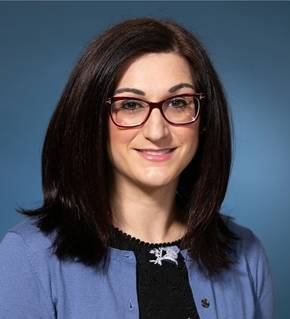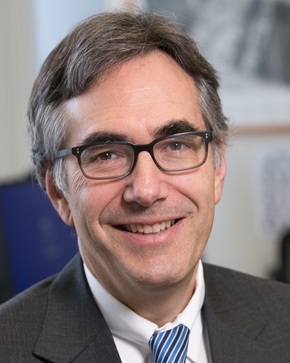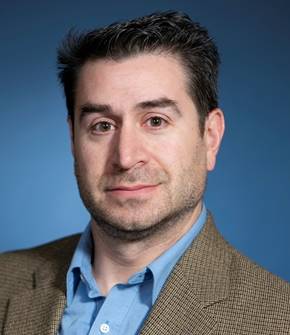- Radiologists at the University of Massachusetts Medical School (UMMS) have become strong brand champions, advocating and acting to change perceptions about the specialty among students and clinical colleagues.
- The imaging department has leveraged opportunities to rebrand radiology through curricula, labs, patient communication skills training, radiology interest groups, and mentorship.
- Their efforts to demonstrate radiology’s true value in patient care resulted in the highest number of students ever matching into radiology, including more women.
Learn more in this Instagram Live event with Carolynn M. DeBenedectis, MD.
For Carolynn M. DeBenedectis, MD, the need to change people’s perception of radiology became abundantly clear the day she matched into the specialty. “One of the doctors at the medical school actually said to me, ‘What a waste of an excellent bedside manner.’ I knew I would use that bedside manner plenty as a radiologist. From that moment on, I wanted to show people how important it is to have radiologists who can talk to patients and demonstrate the key role that radiologists play in patient care.”
DeBenedectis has carried that passion for rebranding radiology into her position as associate professor of radiology and vice chair for education at the University of Massachusetts Medical School (UMMS). “I am proud to be a radiologist. I love what I do, and I know the value we bring to patients,” she says. “In our radiology department, we are taking an active approach to reshaping our brand in the minds of our medical students, residents, and clinical colleagues.”
DeBenedectis’ commitment to rebranding radiology aligns well with how department chair Max P. Rosen, MD, MPH, sees radiology. Changing outdated perceptions of the department has been a key focus for Rosen since he took the helm in 2012. “Under the old brand of radiology, many people perceived radiologists as not having contact with patients. They also saw radiologists as being isolated from other clinicians,” he says. “Because of that misconception, few of our students, especially women, were matching into radiology. So, we set out to change those perceptions.”
 Carolynn M. DeBenedectis, MD, associate professor of radiology and vice chair for education, is working with medical students and residents to showcase the role radiologists play in patient care and the importance of honing excellent patient communication skills. |
The UMMS radiology rebranding campaign is working. “Now our medical students know what we do, and they look at radiology differently,” says Rosen. “In fact, two years after some of these initiatives debuted, we had unparalleled success on match day — the highest number of medical students ever matched into radiology.”
A study of radiology interventions with UMMS medical students — Breaking the Stereotype: Interventions Aimed at Changing Medical Student Misperceptions of Radiology and Increasing the Female Match Rate — showed a decrease in negative misperceptions between first- and fourth-year students. The study also reflected a significant increase in the number of female medical students matching into radiology as a result of the interventions. Since the interventions began in 2012, the number of female medical students matching into radiology increased from 0.76% to 4.2% after four years of intervention.
Building Communication Skills
A core tenet of the UMMS radiology rebranding effort is helping students and colleagues understand that radiologists play a crucial role in communicating with patients. DeBenedectis, who is also director of the radiology residency program at UMMS, took a leadership role in developing patient-focused resources for residents, including a curriculum to teach radiologists — everyone from trainees to attendings — about speaking with patients.“The old perspective the medical school had about radiology was that the department did not make communication with patients and other clinicians a priority,” DeBenedectis says. “My goal was to make communication skills front and center in the hospital and to train residents and attendings how to talk to patients.”
Toward that end, DeBenedectis coupled her passion for patient-focused care with leadership skills she learned through the ACR Radiology Leadership Institute® (RLI). She harnessed both areas of expertise to convince her colleagues to include radiology in a simulation-based training program that the medical center was developing around communicating with patients.
“For me, rebranding radiology started when my chair nominated and encouraged me to join the medical center Disclosure and Apology Committee, which was developing simulation modules around disclosing errors and apologizing to patients,” DeBenedectis explains. “Initially, the committee targeted radiology as the second-to-last specialty to be given a simulation — scenarios in which caregivers disclose errors and offer apologies to ‘patients,’ who are simulation center actors. But I wanted to demonstrate how important radiologists are to communicating with patients and our involvement in patient care. In the committee meetings, I shared personal experiences and examples of how we talk to patients about our findings, and radiology ended up being a part of the first simulation rather than the last.”
As a result of DeBenedectis’ efforts to strengthen radiologists’ communication skills, she also laid the groundwork for developing her own brand as a leader in patient- and family-centered care. “My personal branding came from my desire to rebrand the way people looked at radiology,” she says. “I found something I was passionate about that needed to be changed in radiology, and I started trying to fix it. Before I knew it, I had established my own brand as a leader.” (To learn more about personal branding and DeBenedectis’ journey to build essential leadership skills via the RLI, read the Imaging 3.0 case study “Shaping Your Story.”)
Sparking an Interest
As a changemaker in radiology, DeBenedectis became determined to bring the new perspective of the specialty directly to medical students who might consider entering the field. “Initially, I just started being more available for medical students,” she says. “It was as simple as showing up to medical student events that a radiologist had never attended before and being available to mentor them. Now radiology religiously attends events like the UMMS interest group fair, where the specialties show off what they have to offer, and all of the career planning meetings where residents learn about choosing a specialty.” Max P. Rosen, MD, MPH, professor and chair, Department of Radiology at the University of Massachusetts Medical School, says it is critical to reshape outdated perceptions of radiology among medical students and clinical colleagues. |
Seeing that medical students responded well to such outreach, DeBenedectis expanded her efforts. She and Christopher Cerniglia, DO, associate professor of radiology in the division of musculoskeletal imaging and intervention, are co-advisers of a radiology interest group to cultivate awareness of and interest in the specialty among medical students. During periodic meetups, DeBenedectis and her radiology colleagues offer advice and mentorship to educate participants about the opportunities in radiology and support them as they apply for residency.
What’s more, recognizing that women are underrepresented in radiology — especially in leadership roles — DeBenedectis also started an elective rotation for medical students to provide clinical experience with women in radiology. “We created a program for medical students of any gender to rotate with female attendings to see radiology from their perspective and provide positive female radiologist role models and mentors, especially for female medical students,” she says. “I wanted to rebrand radiology to appeal to the female medical students who thought it wasn’t for them.”
The women in radiology program is showing results. In 2020, two-thirds of UMMS medical students applying to match into radiology are women, a steady increase since the group formed. Victoria Podsiadlo, MD candidate in the Class of 2020, says, “Dr. DeBenedectis’ mentorship was a major influence as I decided to pursue radiology as a career specialty. She has been a spectacular role model and has inspired the way that I hope to practice radiology in the future.”
Integrating Imaging
According to Rosen, another critical component of rebranding radiology with medical students has come from embedding radiology into the first-year curriculum and thoroughly integrating imaging into courses, labs, and hands-on electives. In the past, he says, many students could go through medical school without having any real exposure to radiology. “Radiology wasn’t even on our students’ radar, mainly because it was not part of the core curriculum,” Cerniglia says. “Until recently, they didn’t know the value radiologists provide for patients and the clinicians they serve.”All that’s changing at UMMS thanks to the efforts of radiologists like Cerniglia, who is co-director of the reinvented development, structure, and function (DSF) course that integrates anatomy, physiology, embryology, histology, and medical imaging during the first year of medical school. In 2017, the co-directors tore down the walls that traditionally separated the disciplines to create true integration across each of the course’s 300 learning sessions (the largest first-year course).
“As a radiologist, I wanted to see all of the places where medical imaging could be embedded into all parts of the DSF course — including in lectures, labs, simulations, demonstrations, and even in how we evaluate the students,” says Cerniglia. “Now, our students get to see radiologists beyond just a physician in a dark room reading images. That’s an important part of our rebranding of radiology because they can see our patient interaction and the impact we have on patient care.”
 Christopher Cerniglia, DO, associate professor of radiology in the division of musculoskeletal imaging and intervention, emphasizes that radiologists are diagnosing and treating real patients, not merely interacting with images on a monitor. |
Merging Departments
UMMS integrated imaging even more deeply into its curriculum when the anatomy department merged into the radiology department to become the division of translational anatomy several years ago. “This has given radiology a unique footprint in teaching our first-year medical students,” Rosen says. “Now, some of the first teachers our med students learn from are radiology faculty, and they are beginning to realize that radiology is one of the only areas in medicine where you can learn something about everything.”Under the new department, Cerniglia developed an imaging lab that resides within the anatomy lab, fully blending the radiology and anatomy curricula. “In our integrated resource center, our students learn both through gross anatomic dissection and living imaging. We also bring radiology residents and fellows, as well as faculty members from our department, into the lab for direct interaction.”
First-year medical students aren’t the only ones to gain a richer view of radiology. Cerniglia also developed a hands-on radiology elective for fourth-year students. “Rather than have students sit in the reading room and watch somebody dictate, we treat the fourth-year students almost like residents, where they’re actually reading and dictating cases,” Rosen explains.
Cerniglia, who is also director of undergraduate medical education in the radiology department, says, “The hands-on radiology elective was developed to give medical students a more realistic experience of what a radiologist does in practice. For two weeks, they review films and check scans with an attending radiologist, much like a first-year resident would. It gives them a chance to navigate health records, use a PACS system and voice recognition, and work through detecting and describing findings. They also spend two weeks in mammography and interventional services, where they interact with patients and have clinic sessions. As a result, they have a deeper appreciation of what it really means to be a radiologist.”
Changing Perceptions
Rosen says that all of these efforts have contributed to changing hearts and minds at UMMS about radiology. “It’s critically important for the specialty to make the right first impression among medical students and help them understand the value radiologists bring to patient care,” he says. “Now, our students see radiology as being integral to every aspect of healthcare. In addition, the radiology department is now seen as a key partner and resource to support the educational mission of the medical school.”
DeBenedectis echoes that sentiment. “Radiology needs strong brand champions because of the nature of the profession,” she says. “Here at UMMS, we’re trying to ensure radiologists are no longer invisible. And I am continuing my quest to prove that my excellent bedside manner is serving me well as a radiologist and caregiver.”
Creative Commons
Rebranding Radiology by American College of Radiology is licensed under a Creative Commons Attribution-NonCommercial-NoDerivatives 4.0 International License. Based on a work at www.acr.org/imaging3. Permissions beyond the scope of this license may be available at www.acr.org/Legal.Share Your Story
Have a case study idea you’d like to share with the radiology community? Submit your idea.Next Steps
- Create opportunities for training and simulation to ensure that radiologists in your department or practice have strong patient communication skills.
- Encourage and facilitate radiologists’ participation in medical school or hospital committees to help change other departments’ perceptions of radiologists as stewards of patient care.
- Engage medical students in radiology interest groups and embed radiology into the curriculum and labs to develop better awareness and understanding of what radiologists do and the value they bring to patient care.
Author
Linda Sowers, Imaging 3.0 Consulting Editor
Join the Discussion

#Imaging3 on Twitter
Call for Case Studies
